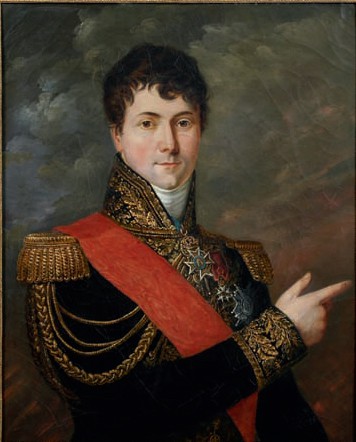Born in Montargis (French department of the Loiret) on 13 February 1768, died in Smolensk from wounds received in Valoutina on 22 August 1812. Was a noble and son of an officer in the Artois regiment; his uncle became General Étienne Gudin.
Gudin studied at the Brienne Military School (where he was a classmate of the future emperor of the French), then became a supernumerary gendarme in the King’s guard, 28 October 1782; replacement second lieutenant in the Artois infantry regiment (which became the 48th infantry in 1791), 2 July 1784; Second Lieutenant, 14 June 1786; Lieutenant, 1 January 1791; embarked for Santo Domingo with the 2nd Battalion of his regiment, 28 January; fought the insurgent natives there; returned to France on 5 July 1792, and returned to his base in Strasbourg; aide-de-camp of his uncle General Etienne Gudin, May 1793; provisional assistant to the Adjutants General of the Armée du Nord in Maubeuge, 30 June 1793; aide-de-camp of General Ferrand in the Armée des Ardennes, 31 October; appointed Adjutant General Chief of the Provisional Battalion by the representatives of the people to the Armée des Ardennes, 26 December 1793; appointed to the General Staff of the Armée du Nord on 19 April 1794; Adjutant General Brigade Chief emp loyed in the Armée de Rhin-et-Moselle, 13 June 1795; Duhesme Division in April 1796; seized Wolfach, 14 July 1796; Chief of Staff of Gouvion-Saint-Cyr, then Chief of Staff of the Kehl garrison in November 1796; at the Gouvion-Saint-Cyr headquarters in January and April 1797; Ambert Division on 20 April 1797; to the Army of England, 12 January 1798; to the Army of Mainz under Lefebvre, October 1798; Brigadier General employed in the Observation Army under Mannheim, 5 February 1799; Commander of a brigade of the Souham division in the Armée du Danube, April 1799; in the 4th division of the centre under Soult in the Armée d’Helvétie, 30 April 1799; Commander of a brigade of the Lecourbe division in the said army, 9 July; seized the Grimsel, 14 August; joined Lecourbe in the battle of the Oberalp, 16 August; was driven out of Airolo and the Gotthard by Souwarow, 23-24 September; crossed the Furka and Grimsel rivers and then returned to the Reuss Valley and took over the Gotthard and Oberalp; Loison division, 2 October; appointed Chief of Staff of Lecourbe to the Armée du Rhin, 5 October; left the Swiss army on 25 October; took part in the battle at Philipsbourg; served the Armée du Rhin as Chief of Staff of the Right Corps under Lecourbe, 1800 ; served at Stein, Stockach, 3 May 1800, Moesskirch, 5 May, Memmingen, 10 May; temporarily commanded a division under Lecourbe instead of Vandamme, 23 May; served at the Lech crossing, 12 June, at Hochstaedt, 19 June, Neuburg, 27 June; commander of the 2nd division of the right wing under Lecourbe, 4 July; confirmed division general on 6 July 1800, by order of the consuls of 22 August 1800; seized Fuessen, 11 July; served at the passage of the Inn, 8 December; at the Salzburg battle, 14 December; Commander of the 10th Military Division at Toulouse, 22 August 1803; employed at the Bruges camp, by rotation with Durutte, as Commander of the 3rd Infantry Division under Davout, 23 August 1804; at the 3rd Corps of the Grande Armée, 30 August 1805; served in Austria, 1805 ; in Prussia, 1806; wounded in Awerstaedt, 14 October 1806; seized Custrin, 1 November; entered Warsaw on 29 November; fought in Nasielsk and Pultusk, 26 December; in Eylau, 8 February 1807; Count of the Empire, 7 June 1808; Commander of the Order of Saint- Henri de Saxe, 1808; Governor of Château de Fontainebleau, 1809; to the Armée d’Allemagne, 12 October 1808; served in Austria, 1809; at Thann; 19 April 1809, Abensberg, 20 April, Eckmuhl, 22 April, Ratisbonne, 23 April, Wittenau, 25 April; seized the bridgehead of Presbourg and the Danube Islands, 30 June; wounded by 4 gunshots in Wagram, 6 July 1809; awarded the Grand Aigle de la Légion d’honneur, 14 August 1809; stationed in Westphalia, then in Magdeburg in February 1810; commander of the 3rd Division of the 1st Corps of the Grande Armée under Davout, 1 April 1812; served in Russia, 1812; attacked Smolensk, 17 August; was mortally wounded by a cannonball that swept his thigh and smashed his calf in the battle at Valoutina, 19 August 1812. Was transported to Smolensk where he died. General Gudin’s name is inscribed on the eastern side of the Arc de Triomphe de l’Etoile in Paris.
Translation of an excerpt from Georges Six, Dictionnaire des généraux et amiraux français de la Révolution et de l’Empire, Paris, Librairie Georges Savoy, 1934


